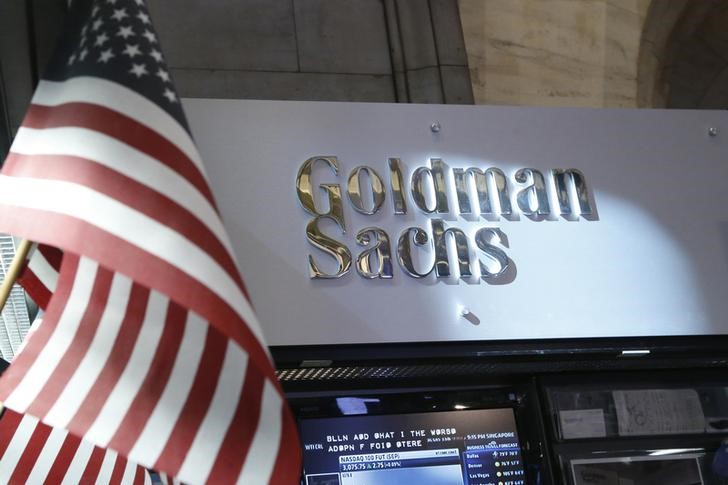(Bloomberg Opinion) -- Goldman Sachs Group Inc (NYSE:GS).’s fourth-quarter earnings were always going to be somewhat messy after the bank announced last week that it would shake up the way it breaks down results by division. The move makes sense for the long term, but more immediately it raises doubts about the accuracy of line-by-line comparisons from a year ago.
To further complicate matters, Goldman on Wednesday disclosed a $1.09 billion legal charge, up from $516 million in the fourth quarter of 2018, as it closes in on a settlement of the so-called 1MDB scandal. That was a chief reason overall expenses reached $7.3 billion, easily exceeding analysts’ $5.422 billion estimate in a Bloomberg survey. That carried over to the headline numbers, which can’t be disguised or attributed to the new reporting structure: Profit dropped 24%, and earnings per share of $4.69 missed analysts’ estimates for $5.52. It was the first back-to-back EPS misses since mid-2011.
Clearly, not even a Wall Street powerhouse can easily offset such a huge buildup in litigation reserves. But that’s not to say it didn’t try.
Aside from the legal charge, Goldman largely followed the trend of its earlier-reporting competitors. Fixed-income trading revenue beat expectations by soaring by 63% from a year earlier, an increase that topped Citigroup Inc.’s 49% but fell short of JPMorgan Chase (NYSE:JPM) & Co.’s 86%. It remained at the top of the rankings for global mergers and acquisitions and equity offerings. The consumer and wealth management division beat analysts’ revenue estimates. Investment banking revenue wasn’t spectacular, but it wasn’t all that much better at the other big U.S. banks.
The temptation, then, is to simply look past Goldman’s role in raising money for state-owned investment fund 1Malaysia Development Bhd and the scrutiny the bank has come under for making some $600 million on the deals. Indeed, some analysts have done just that already. After adjusting for litigation and the 21% effective tax rate that Goldman sees for 2020, core EPS actually came in at $6.49, ahead of an estimate of $5.94, Wolfe Research’s Steven Chubak wrote. “We believe front-loading of investments and higher litigation accrual positions the firm well to drive improved efficiency/returns in 2020 and beyond.”
Along a similar line of thought: “If people feel like they have a handle on what 1MDB will cost Goldman, they will say: ‘Now I know what this is, and the other parts of the business are doing well,’” Sarah Hunt, a portfolio manager at Alpine Woods Capital Investors, said on Bloomberg TV.
It’s understandable why investors and analysts make this argument, even if it feels a little crass. Sure, Goldman was caught up in a global scandal involving embezzlement and money laundering, the thinking goes, but at least there’s a more definitive price tag now.
To be fair, Goldman Chief Executive Officer David Solomon has apologized to the people of Malaysia for the bank’s role in the fraud. And he reiterated in a conference call on Wednesday that the company has been “self-critical” in recent years and that “this is not representative of our longstanding values.”
But that doesn’t mean the company and its shareholders aren’t ready to get the bill and move on, given that this has been looming over the bank since at least 2016. “We are working hard to bring closure,” Solomon said.
Goldman’s revamped reporting structure only further demonstrates its longer-term focus. As Bloomberg News’s Sridhar Natarajan reported, the changes came in response to calls for more clarity from the bank. It did away with its so-called investing and lending reporting line, which was often its most profitable during periods of strong market performance. It will spread interest income across all four of the new segments and create more apples-to-apples comparisons to competitors. It breaks out asset management and consumer banking, two growth areas that diversify the bank away from its usual make-or-break trading and investment banking businesses.
I’ve written before about how Solomon sees the bank “on an evolutionary path” and why it’s going to be a long road ahead. The consumer bank, for instance, brought in $228 million in final three months of 2019. That’s up 23% from the prior year but just a 5% increase from the third quarter. In asset management, net revenue was little changed last year relative to 2018 as an increase in average assets under supervision was offset by lower average fees. Both are on the right track, of course, but the growth is hardly exciting when compared with blockbuster fixed-income trading figures.
Add it all up and Goldman seems committed to playing the long game. It now has the Apple Card fully up and running and has its consumer bank, Marcus, offering a suite of savings options. It has the new reporting structure. And it will hold its first-ever investor day on Jan. 29, which Bloomberg News’s Jenny Surane noted is something of a watershed moment for a company that has been publicly traded for more than two decades. Solomon said the bank would give its financial targets and goals at the investor presentation.
This vision most likely makes the continuing 1MDB saga all the more frustrating for Goldman’s leadership. Until the bank reaches some sort of settlement, it’s bound to be an albatross each quarterly earnings season.
